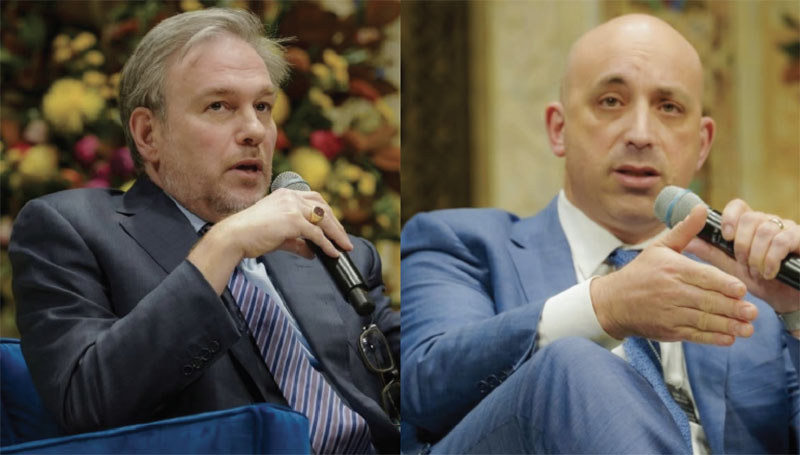For Shannon McGrady Bane, the music of the High Holidays had always welled up into a transcendent, life-changing event. Raised a Methodist, she found the theology of Judaism a better intellectual fit while attending college. There, a rabbi asked her to sing the holiday repertoire.
“It opened up another world for me,” said McGrady Bane, 37, a cantorial soloist at La Mirada’s Temple Beth Ohr, who converted to Judaism and is working on completing her cantorial education.
For many Jews who make an annual pilgrimage to synagogue only during the High Holidays, it is cantors who summon a spiritual experience. “The key that opens the soul is music, not words,” said Shula Kalir-Merton, cantor of Aliso Viejo’s Temple Beth El.
Cantors believe most congregants revel in hearing the repetition of the familiar, traditional chants sung exclusively on High Holidays. Even so, like any performer with a captive audience, some cantors use the showcase to experiment, introducing fresh arrangements of traditional melodies as well as popular ones by contemporary composers.
“This is the high point for cantors; it’s very high drama,” said Cantor Linda Ecker of Fountain Valley’s Congregation B’nai Tzedak. This year, her repertoire of prayers set to music will include three original pieces composed by congregant Ted Bach.
Today, the liturgical music of Conservative and Reform congregations are a blend of traditional melodies, Germanic and high-church in quality, along with others sung in a contemporary-folk style familiar to fans of Bob Dylan, but also popularized among cantors by the late Israeli rabbi, Shlomo Carlebach. For congregants in their 20s and 30s, however, a reliance solely on classical European melodies is a playlist for discontent. “It doesn’t mesh with our spirituality,” said Rabbi Elie Spitz, of Tustin’s Congregation B’nai Israel. After doing without a cantor for 21 years, the synagogue hired Cantor Marcia Tilchin, who appreciates both genres.
Tilchin, along with another newcomer, Svetlana Portnyansky, increase the ranks of women cantors locally to seven. While the Orthodox movements still do not permit women clergy, even in the Reform and Conservative movements it’s only been in the last 25 years that women could officially become cantors. Entrenched attitudes, however, erode even slower. Only in recent years, as old-timers in synagogue leadership are succeeded by baby boomers, are women cantors gaining acceptance, said Abraham B. Shapiro, executive administrator of New York’s Cantors Assembly, the 538-member professional group for Conservative cantors.
The very different backgrounds and training of the new cantors, both hired by Conservative synagogues, illustrate the national shortage of Jewish clergy, a phenomenon true of other religions, too. Their differences also provide a window into the sensitive subject of cantorial professionalism. Many congregations, especially in the Western states, rely on cantors who lack academic credentials. Instead, they learn the distinctive prayer chants in apprenticeships by studying at the elbow of mentor cantors.
The reasons range from geography to historical precedent to regulatory reluctance. In addition, new synagogues are outpacing new graduates, said Cantor Israel Goldstein, director of the School of Sacred Music at Hebrew Union College-Jewish Institute of Religion, which graduated 12 cantors this year. The Conservative Jewish Theological Seminary (JTS) installed nine more as cantors in 2002. Both New York schools are no more than 50 years old.
“Very few congregations would employ rabbis who are not ordained,” Goldstein said. To avoid constitutional conflicts, unlike in other professions, states largely avoid establishing professional standards for clergy.
Portnyansky, 37, named permanent cantor of Newport Beach’s Temple Isaiah, is more accurately called a cantorial soloist since she lacks a diploma or certification by a professional group. A conservatory-trained vocalist, she discovered sacred music in 1988 when the Moscow Jewish Theater reopened 40 years after its closure by Stalin. In 1991, she defected, ditching the Russian music group she toured with in the United States. Though not fluent in Hebrew, Portnyansky auditioned to be accepted by JTS, singing Ukranian folk songs. “They took me,” she said. “I was almost illegal.”
After transferring to Los Angeles’ University of Judaism (said to be considering starting a cantorial program) and taking private lessons, she started working part time as a cantorial soloist in 1994. She continues secular concert work, too. During the holidays, Portnyansky, who lives in Woodland Hills, intends to tinker little with what people expect. She may anyway. “You can improvise from your heart,” she said.
Conversely, Tilchin, 41, a JTS graduate, prays in a traditional style. “I’m like the old guys murmuring with a couple of great, grand pieces thrown in,” said Tilchin, who studied and worked in theater before enrolling in cantorial school in 1992. Given a choice of secular jobs, hers would be country music singer.
“We’re looking for a different kind of music experience than we were in the old days,” she said, when High Holiday soloists sung prayers as operatic arias. Today, she said, “97 percent of the people don’t know the meaning of the prayers. It’s the tune that makes you feel like you’re having a spiritual experience.”
She sees her job as communal cheerleader engaging congregants rather than one defined by the limelight.
The county’s only other invested cantor is Jonathan Grant of Newport Beach’s Temple Bat Yahm.
Historically, only congregations of 600 families or more could afford two full-time clergy. Nationally, cantors — who earn less than rabbis — average $92,500 annually, according to the University of Akron’s Department of Statistics, which surveyed Cantors Assembly members in 2000. The highest paid were in the West, averaging $97,000.
To accommodate second-career students and help address the cantor shortage, the cantorial schools and their movements’ respective professional groups established a certification process. Cantorial soloists can demonstrate their competency during a five-year period. Just four cantorial soloists a year succeed, said Goldstein, of HUC-JIR’s cantorial school.
One who did is Ecker, who graduated in 1998, having sung at the temple’s first service in September 1976. “By the time it opened up to women, I was already married” and established professionally as a senior accountant at UCI’s Medical Center, she said.
“There are more and more untraditional students that the college should start looking at,” argues Cantor Evan Kent, director of cantorial music at HUC-JIR’s Los Angeles campus, which this September will start offering some undergraduate education classes geared to returning students.
The certification process is harder than attending graduate school. “Because when you are in school, you’re tested as you go,” said McGrady Bane, who is working toward certification by taking Judaic studies at HUC-JIR. Passing the cantorial certification requires successfully taking two exams a year apart. “It’s a lot of information to have at your ready,” she said.
McGrady Bane said she loves the music of the High Holidays. “It’s always been my favorite season, because the music is so stirring, majestic and passionate.”
She is using a new piece this year that evokes those emotions; a choral and trumpet piece written for the 134th Psalm by contemporary composer Charles Feldman. “It’s grand. It’s very majestic. It’ll start the new year off right.”






















 More news and opinions than at a Shabbat dinner, right in your inbox.
More news and opinions than at a Shabbat dinner, right in your inbox.